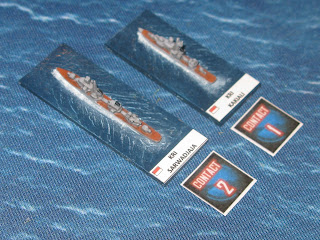In this scenario, set in August 1964, the Royal Navy Type 12 frigate HMS Blackpool is patrolling of the coast of Malaysia in the Malacca Straits at night, when she stumbles across an Indonesian raiding force transporting commandos for a clandestine landing on the west coast. The Indonesian flotilla of the Skory class destroyer KRI Sarwadjaja and the Riga class frigate KRI Kakiali, have orders to attack and destroy any enemy warships encountered, while the Royal Navy rules of engagement state that they cannot open fire unless visual identification has been made or hostile action has occurred.


On Turn 1 and 2 both forces deployed and began moving, with HMS Blackpool steaming eastwards and the Indonesian warships heading north, with all of the ships using contact counters. The islands separating the two forces prevented radar identification, either by HMS Blackpool's active radar search or by the Indonesian's passive radar. In Turn 3, however, KRI Kakiali at the head of the Indonesian flotilla cleared a headland, switched on her radar and made a successful long range detection of HMS Blackpool, which also detected the Kakiali using her active radar sweep. The captain of HMS Blackpool decided to find out what was going on, while the commander of KRI Kakiali ordered the crew to action stations.



In Turn 4, HMS Blackpool altered course 45 degrees to starboard and steamed ahead to investigate and identify the unknown radar target. She also attempted an active radar detection on KRI Sarwadjaja but failed, while the Sarwadjaja successfully detected the frigate using her passive radar. As the Sarwadjaja did not have a data link and was operating in radio silence, she was unaware that KRI Kakiali had already detected HMS Blackpool, so made her own attempt. In most situations, only a single detection counter would have been used at this point, so I removed the passive counter and replaced it with a single active detection counter instead.



The commander of KRI Kakiali decided to make a pre-emptive strike and launched a single heavy wire guided torpedo at HMS Blackpool, which was now in range at just over 15cm distance. The torpedo locked on and hit, causing heavy damage to the engines and propulsion system, together with a fire. These were marked using the tokens provided in the rules. At this point, I moved onto Damage Control but the rules are incomplete and unclear, so I referred back to the previous edition for some clarification. Having done so, I managed to get the fire out and converted it to light damage, but now realise that this attempt actually failed (you need a 10+ not a 7+ as the base roll).
Anyway, in Turn 5 the captain of HMS Blackpool realised too late that the radar target he'd been closing to identify was hostile, so immediately ordered the twin 4.5'' guns to engage the enemy. It was unfortunate, however, that the Indonesians won the initiative roll for the turn, so the KRI Kakiali managed to get off a salvo from her three 100mm medium guns first, achieving two hits. HMS Blackpool fired back but only scored a single hit on KRI Kakiali before KRI Sawadjaja's salvo of four 100m shells smashed home, again inflicting two hits on the British frigate.
The hits inflicted on HMS Blackpool started three fires, added four more heavy damage counters and knocked out one of the 4.5'' guns, as well as all of the secondary weapons and her ECM capability. This was clearly a knock out blow and, in the previous edition of the rules would have sent her straight to the bottom. However, she kept on going despite failing her Damage Control roll, turning 30 degrees to port and limping ahead at half speed in an effort to beach on a nearby island. The Kakiali also suffered with heavy damage and a fire, failing to put out the blaze in the Damage Control phase too.
The final turn was fairly inevitable, with the KRI Sarwadjaja opening up on HMS Blackpool as she steamed past, KRI Kakiali having already moved ahead and out of range. The salvo of four 100m rounds smashed home, resulting in three hits all of which converted into a destroyed result once the pile of damage counters trailing in the frigate's wake had been factored into the equation. HMS Blackpool did manage to get off one round from her single 4.5'' mounting but it failed to hit home. The last act was for KRI Kakiali to put out her fire, allowing both Indonesian warships to complete their mission, winning a minor victory due to the heavy damage on their frigate.

Overall, I really enjoyed this game but had trouble working out the Damage Control mechanisms, which just didn't make any sense as written in the rules. I think I've now worked it out after making some enquiries on the Naval Command FB group, but I'm surprised the rules haven't been updated to fix the issue. The older edition of the rules has a much more detailed and far clearer system, so I may revert to Version 3 for future games, as it seems more comprehensive and well grounded. One thing that I didn't like about the rules was the counter confetti effect, with HMS Blackpool looking like a rubbish lorry on a windy day, as she trailed numerous bits of paper toward the end of the game.
It was all good fun, however, and so another follow on game will be happening some time soon, with the Royal Navy about to strike back against the Indonesians, possibly using her submarine capability?

















A sad day for the RN. Tey would definately be looking for revenge
ReplyDeletenice work
ReplyDeleteA wargmae period never gamed much.
cheers
Matt
Still sounds like a fun game. Maybe keep a name tape or something of table. And apple the chits to the tabs, instead of on the table?
ReplyDelete